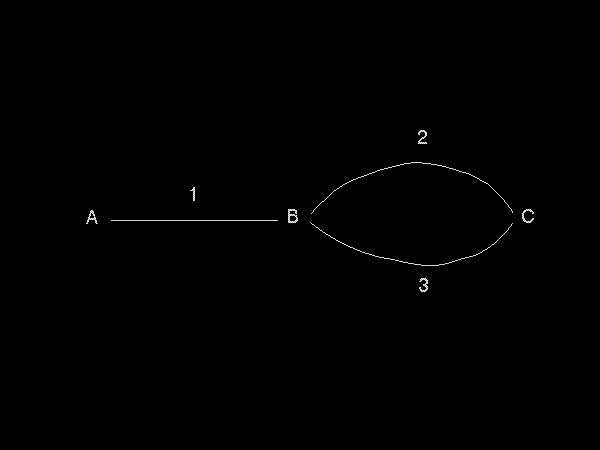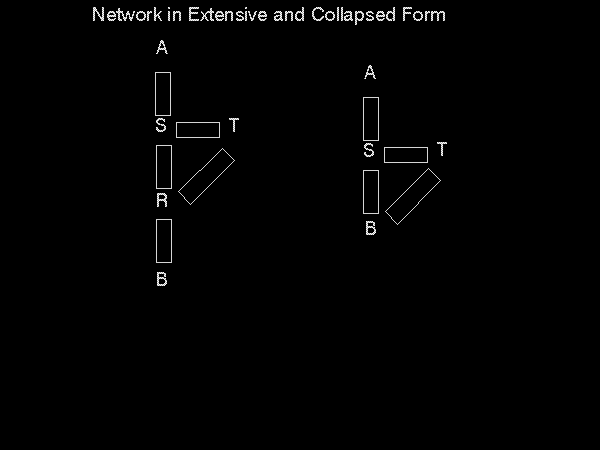
4.2 Interconnection or Foreclosure by a Local Monopolist?

Figure 11: AB is a bottleneck facility.
Many telecommunications, airline networks and railroad networks have the structure of Figure 11. In a railroad network, there may be direct consumer demand for links AB, BC, as well as AC. This figure can also represent a telephone network with demand for local telephone services (AB) and for long distance services (ABC); in that case, there is no direct demand for BC, but only the indirect demand arising from long distance calls ABC. In many cases, one firm has a monopoly of a link that is necessary for a number of services (here AB), and this link is a natural monopoly. This bottleneck link is often called an essential facility. The monopolist can foreclose any firm by denying access to the bottleneck facility. What are his incentives do so?

Figure 12: Intermodal competition.
Economides and Woroch (1992) examine intermodal competition in the context of a simple network pictured in Figure 12. S and R are local switches; AS and BR is local service (in different cities); SR and STR are alternative long distance services. The diagram is simplified by eliminating R without any essential loss. Suppose that an integrated firm offers end-to-end service (ASB), while a second firm offers service of partial coverage only (STB). They find that, although the integrated firm has the opportunity to foreclose the opponent, it prefers not to. In fact, the integrated firm is better off by implementing a vertical price squeeze on the opponent, and charging a significantly higher price to the opponent for the use of the monopolized link than it "charges" itself.27 Thus, foreclosure, although feasible, is not optimal for the integrated firm.28 Economides and Woroch (1992) also find that vertical disintegration is not desirable for the firm that offers end-to-end service. Once disintegrated, its constituent parts realize lower total profits. This is because, besides appropriating monopoly rents for its AS monopoly, the integrated firm (ASB) was creating a significant restriction of competition in SB-STB market by its de facto price discriminating strategy. After disintegration, the SB-STB market becomes much more competitive, even if AS price discriminates between SB and STB. Thus, even if network ASB were to receive the full rent earned by the new owner of SB, its after-divestiture profits would be lower than before divestiture.29
Even in simple networks, there may be relations among firms that are neither purely vertical nor purely horizontal. Thus, the conventional wisdom about vertical and horizontal integration fails. Economides and Salop (1992) discuss pricing in various ownership structures in the model of Figure 7. They call the ownership structure of this figure, where each firm produces a component of each type,parallel vertical integration. They also consider the independent ownership structure, where each of the four components is owned by a different firm. In both of these structures, no firm is purely vertically or purely horizontally related to another firm. Thus, starting from independent ownership, or starting from parallel vertical integration, a merger to joint ownership, where all components are produced by the same firm, can either increase or decrease prices. Thus, simple prescriptions against mergers may easily fail.
In the model of Figure 12, Economides and Woroch (1992) consider the case where link ST is owned by a firm that owns a vertically-related link (either AS or BT), or is owned by an independent firm. Clearly, the strategic structure of the game remains unaffected when link ST changes hands between two firms that also own a link that is vertically related to ST. Therefore, if ST has a fixed cost, it is a liability to such a firm; each firm would like the opponent to own it. However, if the link is owned by a third party, it is has a positive value because of its monopoly position in the chain. Thus, each original owner has an incentive to sell ST to a third party. The direct implication is that the value of links depends on what other links a firm owns. Thus, general prescriptions on the desirability of unbundling of ownership are suspect.
Often parts of the network are regulated, while other parts are not. This is the typical arrangement in telephony in the U.S., where only local telephone companies are tightly regulated, since their market is traditionally considered a natural monopoly.30 Baumol and Sidak (1994a,b) propose that, to attract efficient entrants in the long distance market and to discourage inefficient entrants, a local telephone company should charge them an interconnection (or access) fee equal to the marginal cost of provision of service plus any opportunity cost that the local telephone company incurs.31 This is correct under a set of strict assumptions: first that the end-to-end good is sold originally at the competitive price; second that the entrant produces the same complementary good (long distance service) as the incumbent;32 third, that there are no economies of scale in either one of the complements. Economides and White (1995) discuss how the relaxation of these assumptions leads to different interconnection charges. For example, if competition between an entrant and the incumbent reduces the market power of the incumbent, entry may increase social welfare even when the entrant produces at higher cost than the incumbent.